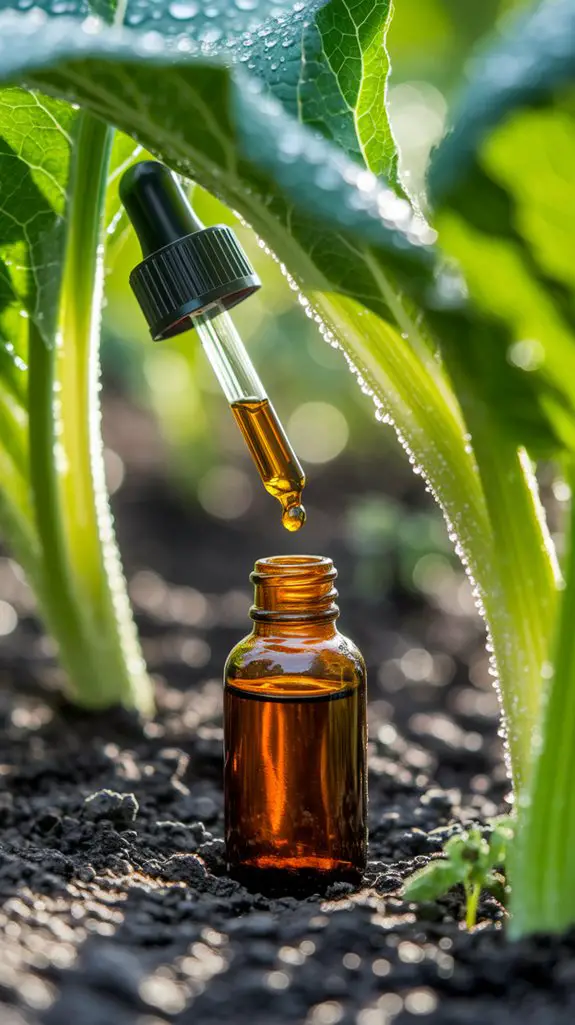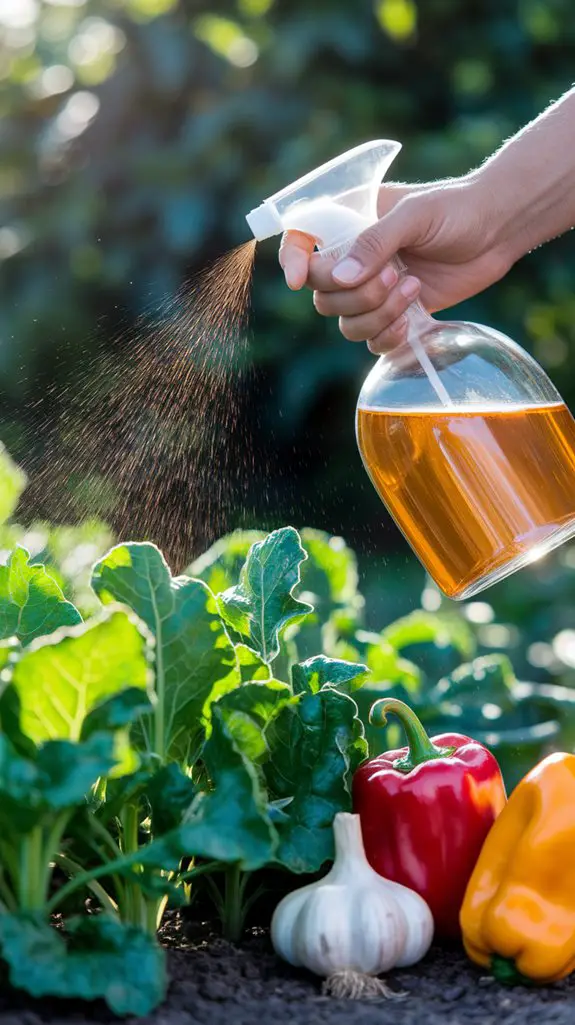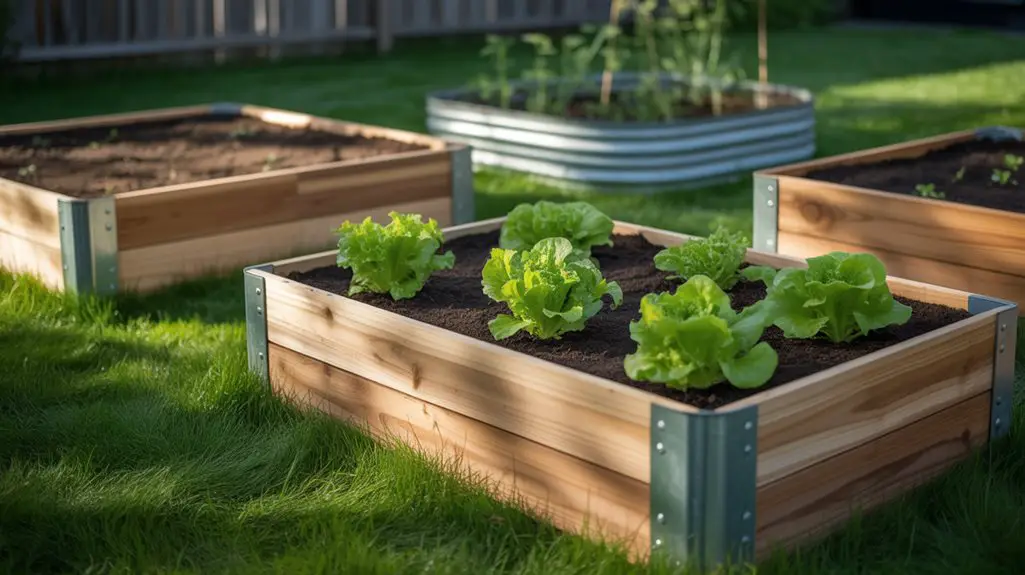As tiny invaders march across your garden battlefield, the quest for chemical-free solutions becomes increasingly urgent. You’ll find several effective natural insecticides that won’t compromise your vegetables’ safety or ecological balance. Neem oil disrupts pest lifecycles, while garlic and hot pepper sprays create powerful deterrents. Diatomaceous earth provides physical control, and simple soap solutions offer quick knockdown effects. These natural alternatives protect your harvest while maintaining the garden’s delicate ecosystem.
Understanding Common Vegetable Garden Pests
Identification of insect pests constitutes the first critical step in implementing effective natural pest management strategies.
You’ll commonly encounter aphids, small sap-sucking insects that cluster on new growth and undersides of leaves, causing distortion and yellowing.
Cabbage worms, the larvae of white butterflies, create distinctive holes in brassicas.
Cucumber beetles, with yellow-green bodies and black markings, transmit bacterial wilt while feeding.
Spider mites, nearly microscopic arachnids, produce characteristic webbing and stippling on leaves.
Squash bugs and squash vine borers target cucurbits specifically, while Colorado potato beetles defoliate solanaceous crops.
Flea beetles create numerous small holes in leaves, reducing photosynthetic capacity.
Each pest exhibits distinct feeding patterns, reproductive cycles, and vulnerabilities that you must understand to select appropriate natural control methods. Implementing natural pest control techniques can further enhance your garden’s defenses against these unwelcome visitors.
Neem Oil: Nature’s Multi-Purpose Pesticide

Neem oil represents one of the most versatile botanical insecticides available to organic gardeners confronting the pests identified above. Extracted from the seeds of the Azadirachta indica tree, this compound contains azadirachtin, which disrupts insect hormonal systems and inhibits feeding behaviors.
Apply as a 0.5-1% solution directly to affected plant surfaces, ensuring complete coverage of leaf undersides where pests often reside.
Neem oil’s efficacy stems from three primary mechanisms:
- Acts as an antifeedant, deterring pests from consuming treated foliage
- Functions as a growth regulator, preventing insects from progressing through life stages
- Reduces reproductive capacity by interfering with egg production and viability
While exhibiting broad-spectrum activity against aphids, whiteflies, and spider mites, neem oil demonstrates minimal toxicity to beneficial organisms when applied at recommended concentrations.
Garlic and Hot Pepper Sprays for Pest Control

Garlic and hot pepper extracts represent two powerful botanical compounds that can be formulated into effective insect deterrents for vegetable crops.
Both contain potent active ingredients—allicin in garlic and capsaicin in hot peppers—that disrupt insect feeding and respiratory functions.
You’ll find these compounds particularly effective against aphids, spider mites, and whiteflies.
To prepare a basic spray, blend 4-5 garlic cloves or 2 hot peppers with 1 liter of water, add 1 tablespoon of mild liquid soap as an emulsifier, then strain and dilute at a 1:4 ratio before application.
Apply these sprays during early morning or evening to prevent leaf burn and maximize effectiveness.
Unlike synthetic pesticides, these botanical solutions break down rapidly, requiring reapplication every 5-7 days, especially after rainfall. Additionally, using homemade pest repellents can further enhance your garden’s defenses against unwanted insects.
Diatomaceous Earth Applications for Vegetable Gardens
While botanical sprays offer systemic pest control through chemical compounds, diatomaceous earth (DE) functions through a different mechanical mode of action. This fossilized diatom powder works by abrading insects’ exoskeletons, causing dehydration and death.
Apply food-grade DE as a dry dust or slurry to soil surfaces and plant foliage when conditions are dry.
For best efficacy, follow these application guidelines:
- Apply at 1-2 lbs per 1,000 square feet using a dust applicator for even distribution.
- Create defensive barriers around plant stems (1/8-inch thick) to prevent crawling insect access.
- Reapply after rainfall as moisture neutralizes DE’s abrasive properties.
DE effectively controls aphids, cucumber beetles, squash bugs, and other common vegetable pests while remaining non-toxic to humans and beneficial soil microorganisms when properly applied.
Beneficial Insects That Combat Garden Pests
Beyond chemical and mechanical interventions, establishing a balanced ecosystem in your garden creates sustainable pest management through beneficial predatory insects.
Ladybugs (Coccinellidae) consume approximately 50-60 aphids per day and also target mites, mealybugs, and scale insects.
Introduce green lacewings (Chrysopidae) to combat thrips, caterpillars, and whiteflies—their larvae devour up to 200 aphids weekly.
For soil-dwelling pests, nematodes (Steinernema and Heterorhabditis species) parasitize cutworms and grubs.
Parasitic wasps (Trichogramma spp.) destroy caterpillar eggs before they hatch, while predatory mites (Phytoseiulus persimilis) specialize in spider mite control.
You’ll achieve ideal results by planting diverse flowering species such as dill, fennel, and alyssum to provide nectar sources and habitat for these beneficial predators throughout their lifecycle.
Essential Oil Blends as Vegetable-Safe Repellents
Essential oil compounds function as potent natural repellents that deter insect pests while maintaining vegetable crop safety.
These volatile terpene-based substances disrupt insects’ olfactory receptors and interfere with neurotransmitter function without compromising vegetable quality or consumer health.
You’ll achieve peak results by implementing these scientifically-validated oil combinations:
- Peppermint-rosemary-thyme (2:2:1 ratio) – effectively repels aphids, whiteflies, and cabbage loopers while preserving beneficial pollinators.
- Neem-lemongrass-eucalyptus (3:1:1 ratio) – disrupts feeding behaviors of cucumber beetles, squash bugs, and Colorado potato beetles.
- Garlic-clove-cinnamon (2:1:1 ratio) – creates a potent barrier against soft-bodied insects like thrips and mealybugs through sulfur compounds.
Apply diluted solutions (1-2% concentration) during morning hours when stomata are open for maximum absorption and effectiveness.
Companion Planting Strategies for Pest Management
Companion planting represents a sophisticated ecological approach that complements chemical deterrents in integrated pest management systems. By strategically positioning specific plants alongside your vegetables, you’ll disrupt pest feeding patterns while attracting beneficial predators.
Implement aromatic herbs like basil, rosemary, and thyme near susceptible crops—their volatile compounds mask chemical signals pests use to locate host plants. Marigolds emit thiophene that repels nematodes, while nasturtiums function as trap crops for aphids. Position alliums (onions, garlic) throughout your garden to deter a broad spectrum of insects.
For maximum efficacy, establish diverse polycultures rather than monocultures. Integrate flowering companions like sweet alyssum to support parasitoid wasps and hoverflies that prey on common vegetable pests. This natural pest control strategy not only enhances biodiversity but also fosters a healthier garden ecosystem.
This biological reinforcement creates resilience against infestations without chemical inputs.
Soap-Based Sprays and Their Effectiveness
Soap-based sprays constitute one of the most effective contact insecticides available to organic gardeners, operating through disruption of cellular membrane integrity in target organisms.
These solutions effectively eliminate aphids, whiteflies, and mites by dissolving the waxy protective coating of their exoskeletons. You’ll achieve peak efficacy by applying a 2-3% concentration of pure castile soap diluted in water.
For maximum effectiveness, consider these critical factors:
- Apply during early morning or late evening to prevent leaf burn from soap-sunlight interactions
- Target spray directly onto pest colonies rather than broadcasting indiscriminately
- Reapply after rainfall as precipitation diminishes residual activity
The mechanism relies on fatty acids penetrating insect respiratory systems, causing cellular leakage and subsequent mortality.
This approach provides targeted pest control without generating the resistance issues associated with synthetic pyrethroid compounds.
Preventative Measures to Reduce Pest Infestations
While chemical interventions provide immediate relief, implementing strategic preventative measures greatly reduces the initial pest pressure on vegetable crops, thereby minimizing the necessity for reactive treatments.
You’ll find companion planting particularly effective—marigolds repel nematodes while nasturtiums deter aphids and squash bugs.
Maintain biodiversity by rotating crops annually to disrupt pest life cycles.
Install floating row covers during critical growth periods and remove them during pollination.
Implement strategic watering practices: irrigate in early morning to guarantee foliage dries before evening, preventing fungal development.
Regular garden sanitation is vital—remove fallen leaves, fruits, and crop residues that harbor overwintering pests.
Healthy soil fortified with compost enhances plants’ natural resistance, as composting enriches soil quality and promotes resilient plant growth.
Monitor your garden bi-weekly using sticky traps to detect infestations early.
Conclusion
With natural insecticides as your botanical arsenal, you’re now equipped to defend your vegetable garden effectively. Implement neem oil, garlic sprays, diatomaceous earth, and soap solutions according to established protocols for maximum efficacy. Integrate these applications with companion planting and preventative cultural practices to establish a thorough integrated pest management system. These biologically-derived controls maintain ecosystem balance while preserving the nutritional integrity of your harvested produce.




